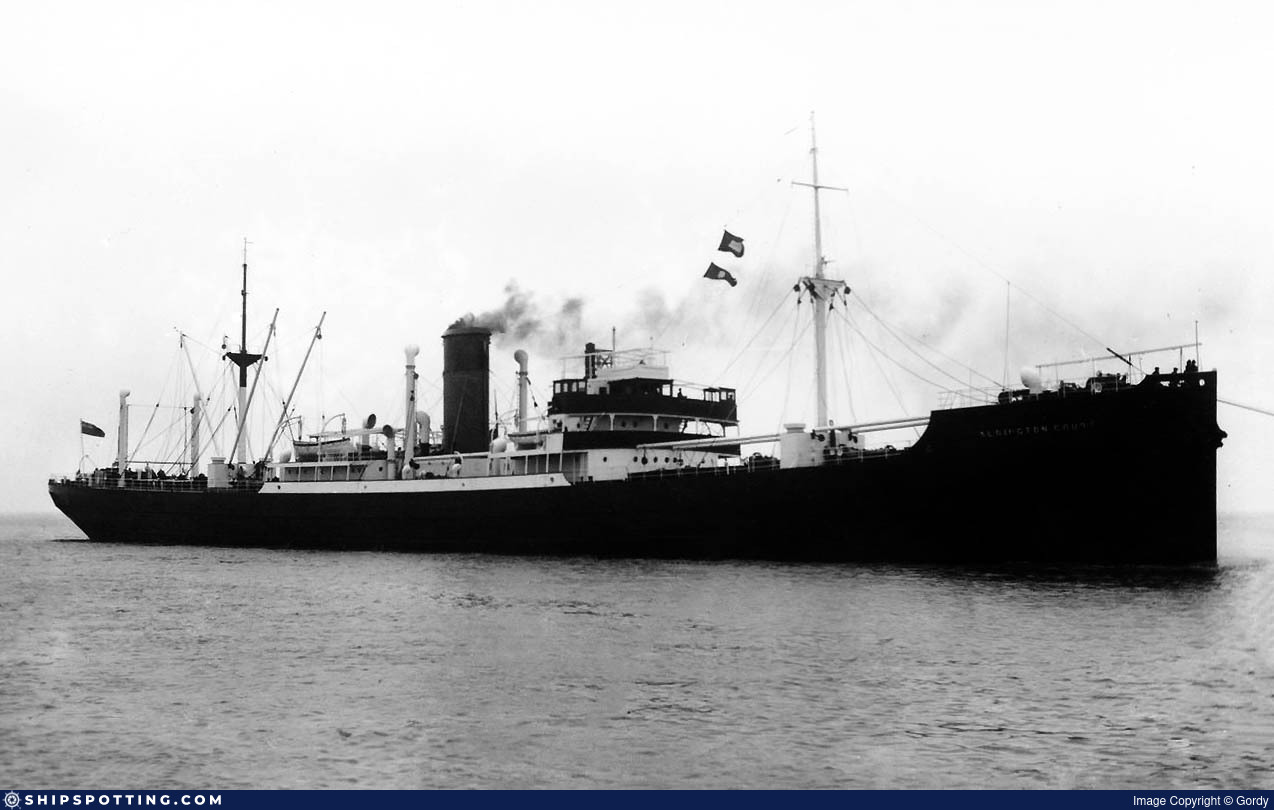
WELCOME TO SHIPSPOTTING.COM
ALDINGTON COURT
Photo
details
Description:
ALDINGTON COURT
Type: Motor merchant
Tonnage 4,891 tons
Completed 1929 - William Pickersgill & Sons Ltd, Sunderland
Owner Court Line Ltd (Haldin & Philipps Ltd), London
Homeport: London
Date of attack 31 Oct 1942 Nationality: British
Fate Sunk by U-172 (Carl Emmermann)
Position 30° 20'S, 2° 10'W - Grid GP 3211
Complement 44 (34 dead and 10 survivors).
Convoy TRIN-16 (dispersed)
Route Philadelphia - Trinidad (9 Oct) - Saldanha Bay, South Africa - Alexandria
Cargo 6614 tons of government stores and general cargo, including coal, tractors, fuel and
beer
History Completed in May 1929
Notes on event
At 22.21 hours on 31 Oct 1942 the unescorted Aldington Court (Master Alfred Stuart) was hit
by two G7a torpedoes from U-172 while steaming on a non-evasive course at 10 knots in fine
weather about 1000 miles west of Port Nolloth, South West Africa. The ship had left Trinidad
in convoy TRIN-16 which was dispersed during the night of 11/12 October. The torpedo tracks
were seen to approach from the starboard beam, but it was too late to take avoiding action
and they struck below the bridge and just forward of the engine room. The explosions threw
up a considerable amount of debris, destroyed both starboard lifeboats, wrecked the gun nest
on the starboard side of the bridge and collapsed the bridge ladders. The crew of 32 and
twelve gunners (the ship was armed with one 4in, one 12pdr, two 20mm and four machine guns)
began to abandon ship in the lifeboats on the port side with great difficulties as it was a
very dark night with no moon and the ship soon listed 35° to starboard. The jolly boat in
charge of the third officer was launched with 13 men in it and the only intact lifeboat was
in charge of the chief officer and left within five minutes with 15 occupants. Others jumped
overboard and swam to rafts that were released. The master, second officer, second radio
officer and a gunner were still aboard when the ship rolled over and sank about 10 minutes
after being hit. They clung to wreckage until two men were picked up by each boat. The U-
boat approached the survivors about 15 minutes later and the Germans asked for the master,
but on being told that he had not been saved they ordered the chief officer to come aboard.
He was taken below for questioning after being blindfolded, asked about the name of the
ship, the cargo and port of destination and handed a pack of 20 cigarettes before he was
sent back to his lifeboat.
At daylight the lifeboat took aboard six men from a nearby raft and the area was searched
for four missing men: three gunners who had been on duty at the stern gun and the first
radio officer who was still sending out distress signals when the ship sank. The jolly boat
only had capacity for seven men, so the number of survivors was reduced from 15 to 10 by
transferring five men to the lifeboat. The master took charge of the bigger boat and set
sail towards South Africa, ordering the jolly boat to keep as close as possible, but the
lifeboat eventually drew ahead as it had more sails and was last seen about 40 miles east-
southeast of the sinking position during the morning of 3 November. It was never found: the
master, 21 crew members and six gunners were lost. The jolly boat made about 4 knots over
the next days until the wind dropped and continued by pulling at intervals for a week,
making very little progress. Thirst became a problem as they were unable to collect rain
water despite seeing heavy squalls passing ahead and behind the boat. Once a large whale
passed the boat several times and almost capsized it. In the afternoon on 13 November, a
ship was sighted and the survivors attempted to attract its attention by igniting all three
available smoke floats; these either malfunctioned or had no effect. They were eventually
spotted after the third officer climbed the mast and waved with a shirt. The City of
Christiania picked up the seven crew members and three gunners, hoisted their boat on board
and unsuccessfully searched for the other lifeboat. The overcrowded jolly boat had sailed
260 miles in 13 days and everyone in it complained about swollen feet as they could barely
move. The survivors were landed in Montevideo on 26 November, where the boatswain was taken
to a hospital. During the rescue he had to be lifted aboard with a rope as he could no
longer move his legs and one of them had to be amputated in the hospital as it was
gangrenous. The remaining survivors were repatriated on the ship which had rescued them,
arriving in the UK on 2 Feb 1943.
Details: Uboat.net
Photo Credits: The South Australian State Library
Vessel
particulars
There is no Ship Data available for this photo!
Would you like to suggest new Ship Data?
Photo
Categories
This ship is not assigned to any other category.




COMMENT THIS PHOTO(1)
Edit
comment